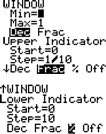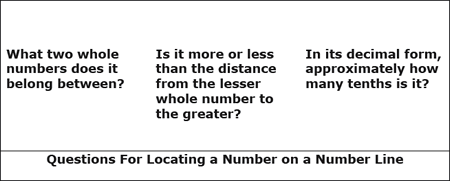Comparing Positive Fractions, Mixed Numbers & Decimal
Main Core Tie
Mathematics Grade 6
Strand: THE NUMBER SYSTEM (6.NS) Standard 6.NS.7
Additional Core Ties
Mathematics Grade 6
Strand: THE NUMBER SYSTEM (6.NS) Standard 6.NS.6
Summary
Compare and order rational numbers in different forms with and without a number line.
Materials
- Worksheets: Comparing Rational Numbers, Locating Rational Numbers on a number line
- Manipulative: Fraction Towers (or centimeter paper for sketching and shading)
- Ti-73's and View Screen, Presenter or Smart View
- Paper for each student to make a foldable
- A card for each team with four pre-printed rational numbers and a number line on each and a few number line transparencies for presenting
Background for Teachers
Enduring Understanding (Big Ideas):
Comparing rational numbers.
Essential Questions:
- How can rational numbers written in different forms be compared?
- Where is a rational number located on a number line?
Skill Focus:
Compare and order rational numbers.
Vocabulary Focus:
Rational number, rational number forms, equivalent, convert, number line, is greater than, is less than.
Ways to Gain/Maintain Attention (Primacy):
Manipulatives, technology, Foldable notes (journaling), visualizing, Game.
Instructional Procedures
Attachments
Starter: Review
- Write each number as a decimal: 3/8, 4 ½
- implify using the correct order of operations: 2.5 + 20 ÷ (3 + 2)
- Which pair of numbers doesn't belong? Explain why?
| 5, 25 | 3, 9 | 6, 12 | 8, 64 |
Sometimes it is necessary to know which of two or more rational numbers is the greatest or the least. We need strategies to be able to compare rational numbers. Following are three strategies for comparing.
- One strategy is to build or sketch models to compare values. Use Fraction Towers or Centimeter, or graph paper to help students make predictions using models by completing "Comparing Rational Numbers" worksheet (attached)
- A number line can also be used to compare rational numbers. Use the Numline Application on the TI-73 to compare rational numbers
Using the Numline App To Compare Rational Number
You must have the Numline App downloaded on your calculator, if it is not preloaded. Select . Choose Numline. In Numline, select Fraction line. Push
. Choose Numline. In Numline, select Fraction line. Push  and set the window as shown below. You may select a different minimum and maximum if you want numbers greater than 1. The "Start" can be adjusted to begin at any point on the number line. The "Step" can be adjusted to be increments common to both number using the LCD of two numbers.
and set the window as shown below. You may select a different minimum and maximum if you want numbers greater than 1. The "Start" can be adjusted to begin at any point on the number line. The "Step" can be adjusted to be increments common to both number using the LCD of two numbers.
 After the window is set, press
After the window is set, press 
 . The screen will look like this:
. The screen will look like this:

The upper indicator can be a decimal, fraction, or percent. The lower indicator can also be decimal, fraction, or percent form. Thus you can compare numbers using different forms.
On the number line view, use the up or down arrow keys to select the upper indicator (top) or the lower indicator (bottom). Using the right and left arrow keys, you can then move the indicators along the line to find values in increments of tenths or any step you have chosen.
To show a specific rational number or compare several rational numbers using the number line, push . Select DrawLabel. Type a rational number and push
. Select DrawLabel. Type a rational number and push  . Then type another rational number and push
. Then type another rational number and push  . You can compare several rational numbers, percents, or ratios by looking at their distance from 0.
. You can compare several rational numbers, percents, or ratios by looking at their distance from 0.
Use the back of the "Comparing Rational Numbers" worksheet to sketch number lines to show each of the comparisons on that worksheet. - A third way to compare rational numbers is to first write each number in its decimal form. As discussed in the precious lesson, numbers can be converted to another form such as the decimal form for a rational number. Once both numbers are converted to a decimal form, the two decimal can be compared. This procedure could be done by:
- Convert both numbers to decimal form.
- Use zeros as place holders to write each number to the same decimal place.
- Compare the value of both numbers to determine which is greatest.
On the back of the "Comparing Rational Numbers" worksheets, write each pair of numbers listed on the front in decimal form and use < or > to write an inequality statement.
Once you have determined which number is greatest and which is least you can find the approximate location of the numbers on a number line by
Lesson Segment 2: Where is a rational number located on a number line?
When we have misplaced something and need to find it, we generally begin by asking ourselves questions such as: Where should it be? When did I see it last? What was near it? To find where a number belongs on the number line, we ask questions too. Here are some questions that can help us determine where a number is located?
Questions:
- What two whole numbers does it belong between?
- Is it more or less than half the distance from the lesser whole number to the greater?
- If it's a fraction is the numerator less than half or more than half the denominator?
- If it's a decimal, is the decimal part more than 0.5 or less than 0.5?
- If it's a percent, is it more than 50% or less than 50%
- In its decimal form, approximately how many tenths is it?
An example: Locate 3.25.
- What two whole numbers does it belong between? 3.25 is more than three and less than 4

- Is it more or less than half the distance from the lesser whole number to the greater?
If it's a fraction is the numerator less than half or more than half the denominator?- If it's a decimal, is the decimal part more than 0.5 or less than 0.5? Its less than 0.5.
- If it's a percent, is it more than 50% or less than 50%

- In its decimal form, approximately how many tenths is it? Close to 0.3

Help students with example of locating a rational number on a number line by completing the Locating Numbers on a Number Line worksheet together.
Have students take notes on a three flap foldable for the three questions below as shown. They should write an example of their own under each flap. Students should answer the question about the number under the flap, then sketch a number line to show the answer to that question below.

Lesson Segment 3: Practice
Play the following game for practice and engagement.
Materials: A card for each team (see attached examples), Number line transparencies
Procedure: Each team begins with 5 points. Give each team a card with four numbers and a number line (see attached). Each team will work together to order their numbers from least to greatest, and then plot their locations on the number line. Once the teams have done this, they will take turns in challenging the class to order and plot their numbers in this manner:
- A challenging team writes all four numbers out of order on the overhead
- The other teams are given time to work to order and plot those numbers.
- The challenging team selects one person in the class to answer the problem and show the plot on a transparency.
- If the person correctly orders and plots the numbers, the challengers have to give them one of their points. If not, the incorrect team must give the challengers a point and the teacher selects a person from the challenging team to answer and plot to earn that point for their team.
Teams should be given rational numbers that fall between two consecutive whole numbers. For example, team 1 could be given numbers between 0 and 1. Team 2 could be assigned numbers between 1 and 2. Team three could be given numbers between 2 and 3. Team four's numbers would fall between 3 and 4 etc. Two example cards and the blank card for you to fill in for each team prior to the lesson are attached.
Assign any text practice as needed.
Assessment Plan
Performance task, observation.
Bibliography
This lesson plan was created by Linda Bolin.
Updated: 02/05/2018


 UTAH EDUCATION NETWORK
UTAH EDUCATION NETWORK

 Justin
Justin Braxton
Braxton Dani
Dani Kayla
Kayla Katie
Katie Matthew
Matthew Rob
Rob Val
Val
